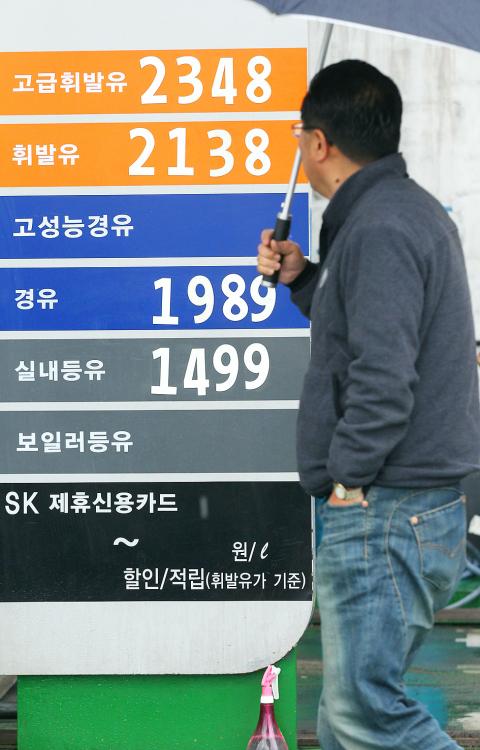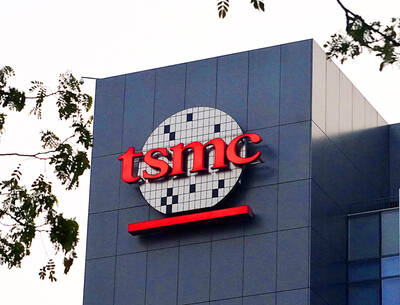OPEC can make up for the loss of any crude production from Libya, Qatari Oil Minister Mohammed Saleh al-Sada said, after prices last week surged to a two-year high.
Al-Sada told reporters in Doha Sunday there is no shortage in oil supply. Concern that political upheaval in North Africa and the Middle East would disrupt supplies drove the price of crude to US$103.41 a barrel last week, the highest level since September 2008. Libya holds the largest proven oil reserves in Africa.
Al-Sada’s comments echoed those of a Saudi Arabian oil official, who said on Thursday there was no reason for oil prices to rise because Saudi Arabia and OPEC wouldn’t allow shortages to exist. Qatar and Libya are among the 12 members of OPEC, which pumps about 40 percent of the world’s oil. Saudi Arabia is the group’s largest and most influential member.

Photo: EPA
Their remarks came after more than a week of turmoil in Libya, with production scaled back by almost 90 percent and many employees fleeing and ships not coming to collect its products.
The seaside Brega complex, about 200km west of the rebel stronghold of Benghazi, collects crude oil and gas from Libya’s fields in the southeast and prepares it for export. It also produces some petrochemicals and refined products for local consumption.
Since the crisis began on Feb. 15, however, General Manager Fathi Eissa said the facility has had to scale back production dramatically from 90,000 barrels of crude a day to just 11,000.
There are no reliable figures about the impact of the uprising against Libyan leader Muammar Qaddafi on Libya’s oil exports, but facilities across the country have been forced to make sharp cuts. Most Libyan ports — the main method of export — also were closed due to bad weather, staff shortages or production outages, according to the International Energy Agency (IEA).
The IEA, citing reports from Western producers, said overall crude production has dropped from 1.6 million barrels per day to 850,000.
“Almost all international oil companies operating in Libya have reported partial or full shut-in of output,” the IEA said a statement on Friday. These companies account for about 72 percent of the North African country’s output. The status of oil fields operated by the National Oil Corp, which accounts for the remaining 28 percent of production, was “still unclear,” the Paris-based agency said.
At Brega, the huge spherical storage containers and reservoirs used to hold natural gas and crude oil are filling up rapidly with no ships to cart away their valuable contents.
Production in the southern fields has been throttled back until Brega can clear some of its capacity.
“At this time, we are operating with the minimum required number of operators, technicians mainly,” Eissa said. “The -production from the fields right now is at minimum, it is not completely stopped, but it is minimum.”
On Saturday, a ship arrived to collect some ammonia and methanol, but it was one of only a few since the troubles began.
The neighboring petrochemical complex of Ras Lanouf, about 100km to the west has experienced similar drops in manpower and has also had to cut production.
Ras Lanouf is also perilously close to the town of Sirte, one of the last holdouts for Qaddafi loyalists in central Libya, raising concern about clashes in the area.
The Gulf of Sidra is critical to Libya’s energy exports. The ports of As Sidra, Marsa el Brega, Ras Lanuf, Tobruk and Zuetina handle about 77 percent of Libya’s oil exports. Allegiances in the Gulf of Sidra and the economic value they represent, therefore, are key to the survival of Qaddafi’s regime.
Many of Brega’s 600 foreign workers — mostly from Britain and other European countries — were preparing to evacuate.
The British frigate HMS Cumberland, which took evacuees from Benghazi to Malta, is set to return to pick up many of Brega’s workers. They missed an earlier evacuation at Benghazi because of the poor state of communications in the country.

Taiwan’s long-term economic competitiveness will hinge not only on national champions like Taiwan Semiconductor Manufacturing Co. (TSMC, 台積電) but also on the widespread adoption of artificial intelligence (AI) and other emerging technologies, a US-based scholar has said. At a lecture in Taipei on Tuesday, Jeffrey Ding, assistant professor of political science at the George Washington University and author of "Technology and the Rise of Great Powers," argued that historical experience shows that general-purpose technologies (GPTs) — such as electricity, computers and now AI — shape long-term economic advantages through their diffusion across the broader economy. "What really matters is not who pioneers

In a high-security Shenzhen laboratory, Chinese scientists have built what Washington has spent years trying to prevent: a prototype of a machine capable of producing the cutting-edge semiconductor chips that power artificial intelligence (AI), smartphones and weapons central to Western military dominance, Reuters has learned. Completed early this year and undergoing testing, the prototype fills nearly an entire factory floor. It was built by a team of former engineers from Dutch semiconductor giant ASML who reverse-engineered the company’s extreme ultraviolet lithography (EUV) machines, according to two people with knowledge of the project. EUV machines sit at the heart of a technological Cold

TAIWAN VALUE CHAIN: Foxtron is to fully own Luxgen following the transaction and it plans to launch a new electric model, the Foxtron Bria, in Taiwan next year Yulon Motor Co (裕隆汽車) yesterday said that its board of directors approved the disposal of its electric vehicle (EV) unit, Luxgen Motor Co (納智捷汽車), to Foxtron Vehicle Technologies Co (鴻華先進) for NT$787.6 million (US$24.98 million). Foxtron, a half-half joint venture between Yulon affiliate Hua-Chuang Automobile Information Technical Center Co (華創車電) and Hon Hai Precision Industry Co (鴻海精密), expects to wrap up the deal in the first quarter of next year. Foxtron would fully own Luxgen following the transaction, including five car distributing companies, outlets and all employees. The deal is subject to the approval of the Fair Trade Commission, Foxtron said. “Foxtron will be

INFLATION CONSIDERATION: The BOJ governor said that it would ‘keep making appropriate decisions’ and would adjust depending on the economy and prices The Bank of Japan (BOJ) yesterday raised its benchmark interest rate to the highest in 30 years and said more increases are in the pipeline if conditions allow, in a sign of growing conviction that it can attain the stable inflation target it has pursued for more than a decade. Bank of Japan Governor Kazuo Ueda’s policy board increased the rate by 0.2 percentage points to 0.75 percent, in a unanimous decision, the bank said in a statement. The central bank cited the rising likelihood of its economic outlook being realized. The rate change was expected by all 50 economists surveyed by Bloomberg. The